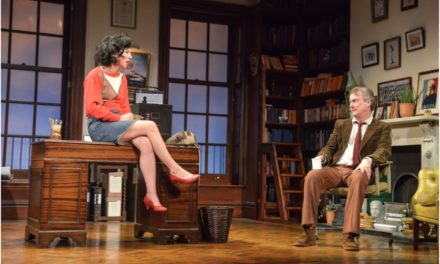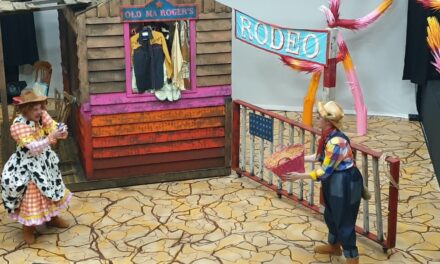The lovesick maidens admire Bunthorne – photo ©Richard Hubert Smith via ETO website
Patience was the sixth Gilbert and Sullivan opera, first produced in 1881, and proved to be a popular work both in the original record breaking run of 578 performances and in the many revivals since.
It may seem a curious choice for a serious professional company such as the ETO to address, but their joyous and energetic production shows that what appears initially a rather silly indulgence is in fact a complex, well structured and beautifully composed work.
Gilbert and Sullivan built their success by crafting fine light operas with sublime and memorable music, tongue twistingly clever lyrics, high production values and a host of contemporary references. Some of the more contemporary nuances may be lost on a modern audience, but this matters little when there is such fine music and witty characterisation set before us.
The complexities of the romantic interactions in Patience would make a chess grand master hesitate, although this complexity does require some rather simple and straightforward analysis of the tricky matter of love and how to best procure it.
The ‘several lovesick maidens’ burst onto the stage at the very start with all the heft and purpose of a third marriage hen night at your local Chicago night club and waste little time in making their purpose clear. This is not a tale told with modern sensibility, rather a cartoon version of the dating game in the most lurid of bright colours.
The contemporary references from the time of the opera’s first production refer to the then prevalent obsession with aestheticism, where we are led to believe that a suitably dandified young verse maker could whip up a delirious frenzy of female lust at the drop of his velvet hat. Pass him by a chorus of ladies one rejection away from a decline into spinsterhood and and the scene is set.
Our first dandy is the poet Bunthorne. History is blurred as to whether he was modelled on Oscar Wilde, or whether indeed Wilde adopted a measure of the Bunthorne aura. Swinburne and Rosetti were also considered to be inspirations for this ‘fleshly poet’. Bunthorne was first brought to life by George Grossmith, first master of the G&S ‘patter song’ performances that challenge the singer and delight the audience in equal measure. In Patience there is less patter and more pathos, as the hand wringing Bunthorne repeatedly fails to find the ‘Bunthorne’s Bride’ of the opera subtitle.
Our Bunthorne is Bradley Travis, and his nemesis is fellow aesthetic poet Archibald Grosvenor (Ross Ramgobin) as they tussle for the love of milkmaid Patience, an innocent and straightforward young lovely brought to delightful life by Soprano Lucy Briginshaw. Unlike the heaving bosom choir of the lovesick maidens Patience has not really had time to ponder on the joys of love yet, although it turns out that Archibald was her childhood sweetheart who still yearns for her. As, rather unfortunately, does Bunthorne, who spurns his chorus of followers for the love of Patience in a largely unrequited quest.
The male chorus is a squadron of Dragoons, back from battle and ready for a spot of spooning with their previously devoted lovesick maidens. Sadly absence has not made their amour fonder, as their heads have all been turned by the aesthetic dandy. The opera moves from comic to surreal in one scene where three of the soldiers, including the ludicrously rich Duke of Dunstable (Aled Hall), attempt to encompass the life aesthetic in their quest for romance.
Plainest of the lovesick maidens is The Lady Jane, sung tonight by understudy Susan Moore. You would not know this, as she delivers a masterpiece of comic timing and performance in this Contralto role, and receives warm applause for her efforts at the curtain call.
There is a deal of to-ing and fro-ing to keep us entertained as the complex plot develops, all bound together by the ‘most beautiful score written for the English stage’ as the programme proclaims. This is production that is true to the original to a high degree, but enhanced with the superb dance and musical skills of one of our finest modern opera companies. Unlike the Italian classics that the company also produce nobody dies and almost everyone (except poor Bunthorne) toodles off to a suitably jolly matrimony. The set shares with the ETO Tosca the designer Florence De Maré and while less stark is equally bold, giving great scope for some comic hide and seek at various points.
Gilbert and Sullivan perfected the light opera as a storytelling medium, and Patience is amongst their most finely crafted works. English Touring Opera have made a great choice in reviving this popular show, and doing so with great panache and style. For a cheering night out at the Theatre this is hard to beat, with a light touch that belies the great skill and effort of everyone involved in this gorgeous production.
©Julian Swainson
Read more about the ETO Patience here: http://englishtouringopera.org.uk/productions/patience




Recent Comments